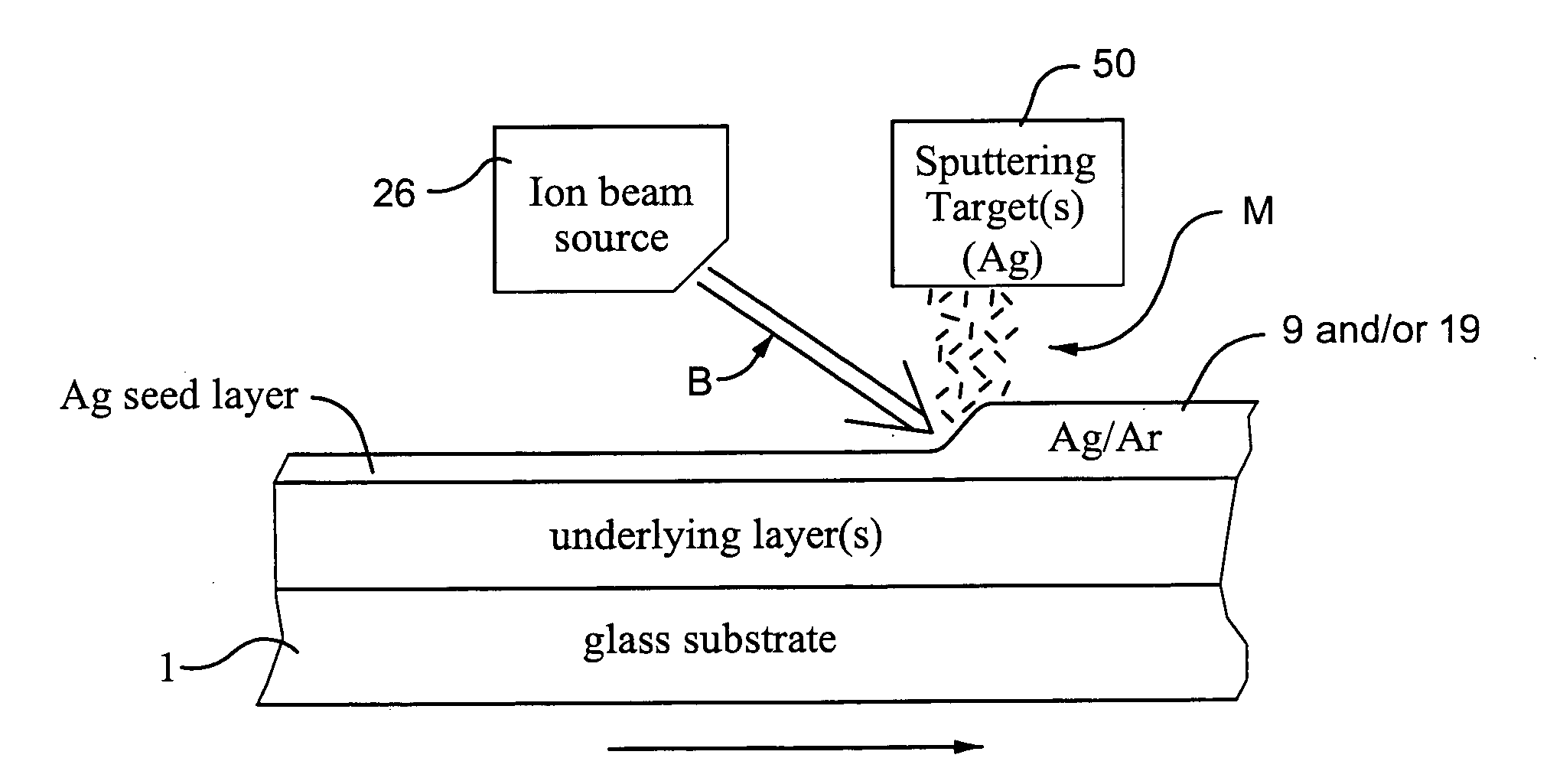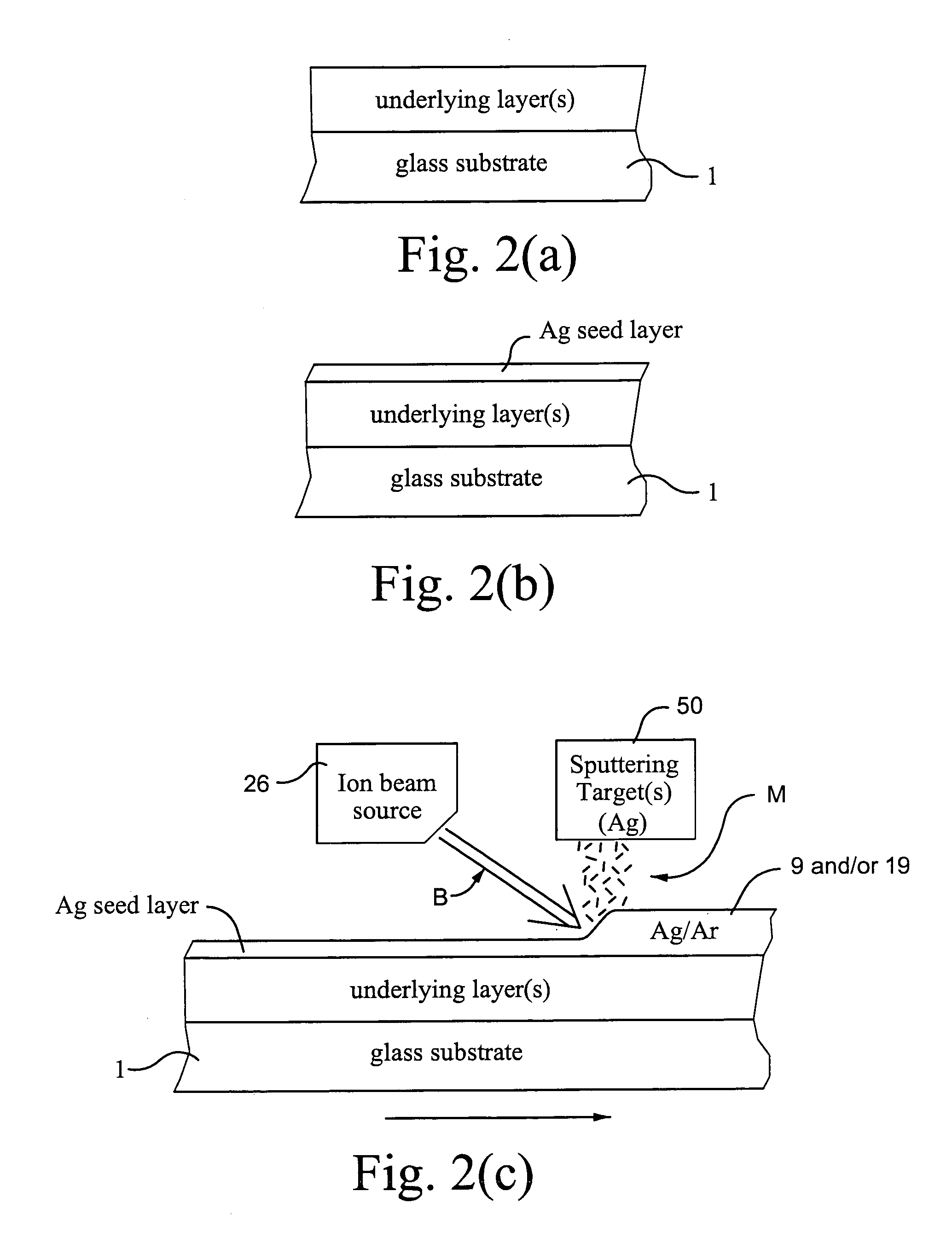Coated article having low-E coating with ion beam treated IR reflecting layer and corresponding method
a technology of ion beam and reflective layer, which is applied in the direction of vacuum evaporation coating, coating, water-setting substance layered product, etc., can solve the problems of undesirable drop in visible transmission, undesirable color shift of product, and difficulty in obtaining high visible transmission, so as to improve the ir reflecting characteristics, improve the electric resistance of the ir reflecting layer, and improve the durability of the coated article
- Summary
- Abstract
- Description
- Claims
- Application Information
AI Technical Summary
Benefits of technology
Problems solved by technology
Method used
Image
Examples
examples
[0069]In Example 1, an IR reflecting layer of Ag was formed on a 100 Å thick ZnO layer. In forming the IR reflecting layer, an Ag seed layer about 60 Å thick was first deposited via sputtering, and thereafter the remainder of the IR reflecting layer was formed using IBAD. The IBAD, at room temperature, utilized a silver sputtering target and an ion beam of argon ions, where the average ion energy was from about 200 to 250 eV per Ar+ ion.
[0070]Comparative Example 1 was the same as Example 1 above, except that the entire Ag IR reflecting layer was formed using only sputtering (no IBAD was used). The results comparing Example 1 and Comparative Example are set forth below.
[0071]
Ex. 1Comparative Ex. 1Ag Thickness (total):120 Å120 ÅSheet Resistance (Rs, ohms / square):3.03.8IBAD:yesnoIon Energy per Ar+ ion:200-250 eV0Stress Type:compressivetensile
[0072]It can be seen from the above that the use of IBAD (see Example 1) in helping form the IR reflecting layer resulted in a significantly impro...
example 6
[0086]Example 6 used post-sputtering peening type of ion beam treatment, and was made and tested as follows. A silicon nitride layer about 425 Å thick was deposited by conventional magnetron-type sputtering using a Si target doped with Al on a substrate. After being sputter-deposited, the silicon nitride layer had a tensile stress of 400 MPa as tested on the quartz wafer. After being sputter-deposited and stress tested, the silicon nitride layer was ion beam treated using an ion source 26 as shown in FIGS. 4-5 under the following conditions: ion energy of 750 eV per N ion; treatment time of about 18 seconds (3 passes at 6 seconds per pass); and N2 gas used in the ion source. After being ion beam treated, the silicon nitride layer was again tested for stress, and had a tensile stress of only 50 MPa. Thus, the post-sputtering ion beam treatment caused the tensile stress of the silicon nitride layer to drop from 400 MPa down to 50 MPa (a drop of 87.5%).
example 7
[0087]The following hypothetical Example 7 is provided for purposes of example only and without limitation, and uses a 2.1 mm thick clear glass substrates so as to have approximately the layer stack set forth below and shown in FIG. 3. The layer thicknesses are approximations, and are in units of angstroms (Å).
[0088]
Layer Stack for Example 7LayerGlass SubstrateThickness (Å)N-doped Si3N4100ZnAlOx109Ag96NiCrOx25SnO2535SixNy126ZnAlOx115Ag95NiCrOx25SnO2127N-doped Si3N4237
[0089]The processes used in forming the coated article of Example 7 are set forth below. The sputtering gas flows (argon (Ar), oxygen (O), and nitrogen (N)) in the below table are in units of sccm (gas correction factor of about 1.39 may be applicable for argon gas flows herein), and include both tuning gas and gas introduced through the main. The line speed was about 5 m / min. The pressures are in units of mbar×10−3. The silicon (Si) targets, and thus the silicon nitride layers, were doped with aluminum (Al). The Zn tar...
PUM
| Property | Measurement | Unit |
|---|---|---|
| concentration | aaaaa | aaaaa |
| concentration | aaaaa | aaaaa |
| concentration | aaaaa | aaaaa |
Abstract
Description
Claims
Application Information
 Login to View More
Login to View More - R&D
- Intellectual Property
- Life Sciences
- Materials
- Tech Scout
- Unparalleled Data Quality
- Higher Quality Content
- 60% Fewer Hallucinations
Browse by: Latest US Patents, China's latest patents, Technical Efficacy Thesaurus, Application Domain, Technology Topic, Popular Technical Reports.
© 2025 PatSnap. All rights reserved.Legal|Privacy policy|Modern Slavery Act Transparency Statement|Sitemap|About US| Contact US: help@patsnap.com



